Haydn, Violin Concerto No1 Hob. VIIA No1 in C Major( Henle)
Joseph Haydn, Violin Concerto in C Major (Hob.VIIA:1). Edited by Stefan Zorzor. Pubished by G. Henle Verlag.
Joseph Haydn, an Austrian composer born on March 31, 1732, played a pivotal role in the growth and development of classical music in the 18th century. His contributions to the string quartet and symphony genres revolutionized the musical landscape of his time. Haydn's prodigious output of music showcased his immense talent and creativity.
Early Life and Musical Development
Joseph Haydn's musical journey began in his early childhood. He was exposed to the pompous and complex musical idiom of the Baroque period, which was prevalent at the time. However, as he grew older, Haydn embraced the bright, joyful, and elegant musical style that characterized Austria during his early career. Influenced by composers like Carl Philipp Emanuel Bach, Haydn gradually developed his unique musical identity by combining elements from different genres.
In the 1760s, Haydn's musical style started to solidify and deepen. He introduced a new method of dealing with small motifs, which added a dramatic element to the first movement of his sonatas, quartets, and symphonies. During this period, his music took on a darker hue, reflecting an intellectualization that had been slowly evolving. However, it wasn't until the mid-1780s that Haydn fully recovered the emotional vitality that had been missing from his work since the early 1770s.
Haydn's Paris Symphonies: Elegance and Profundity
One of the highlights of Haydn's career was his time in Paris, where he composed a series of symphonies that exemplified elegance, formal excellence, and profound musical depth. Among these symphonies, Symphony No. 86 in D stands out as a marvel of musical craftsmanship. Haydn's Paris symphonies showcased his ability to fuse harmonious principles with older contrapuntal styles, creating a perfect balance between accessibility and depth.
Haydn's London Tours and Late Works
Haydn embarked on several tours to London, which brought a new force and energy to his music. However, as an aging composer, his compositions started to reflect a deeper emotional depth, accompanied by increased nervous stress. In his late piano trios, Haydn experimented with new harmonic partnerships, pushing the boundaries of musical expression. Upon returning to Vienna, he turned his focus primarily to vocal and string quartet music.
The Legacy of Haydn's Late Works
Haydn's final works, such as the Mass in Tempore Belli (1796) and the Nelson Mass in D minor (1798), exemplify his mastery of symphonic vitality and grandeur. These compositions combine solo voices, a vocal quartet, and chorus, juxtaposing accessible melodies with powerful harmonies. Additionally, Haydn's instrumental pieces, including the Erdödy quartets (Opus 76; 1797) and the Lobkowitz quartets (Opus 77; 1799), elevated the art of the quartet to a new standard.
Haydn and the Enlightenment
Joseph Haydn was a true representative of the Enlightenment era. His music embodied a positive outlook on life, a fusion of intellect and sentiment, and a sense of restraint that avoided highly discordant moods. These qualities resonated with his contemporaries, as Haydn's music exuded nobility, manipulative simplicity, and charming bursts of humor. Despite falling out of favor during the late 19th century, Haydn's work was reevaluated in the 20th century, with his thematic elaborations, humor, modulations, and orchestration recognized for their originality and craftsmanship.
Conclusion
Joseph Haydn's contributions to classical music are immeasurable. His innovative approach to composition and his ability to blend different musical styles set him apart as a truly remarkable composer. From his early works to his late masterpieces, Haydn's music continues to captivate audiences with its elegance, profundity, and emotional depth. As we delve into the rich tapestry of Haydn's compositions, we can appreciate the lasting impact he has had on the classical music genre.

Joseph Haydn, Violin Concerto in C Major (Hob.VIIA:1). Edited by Stefan Zorzor. Pubished by G. Henle Verlag.
Haydn, Violin Concerto No2 Hob 7A No 4 in G major (Peters)